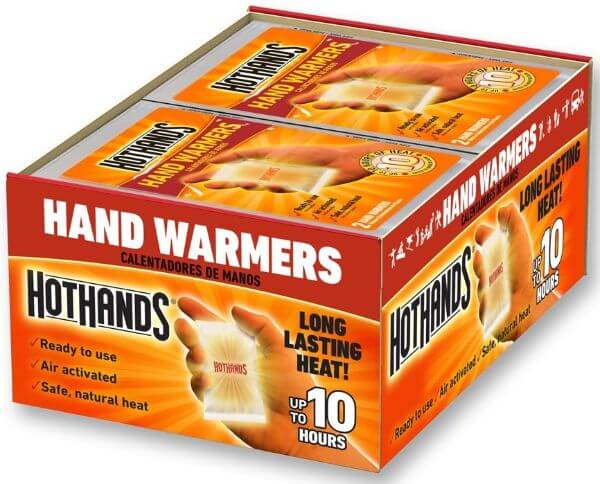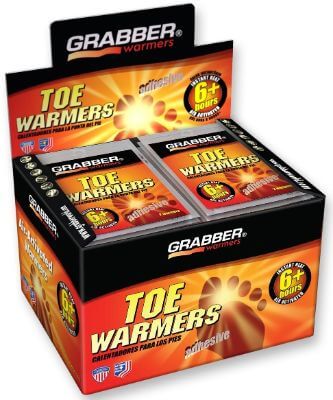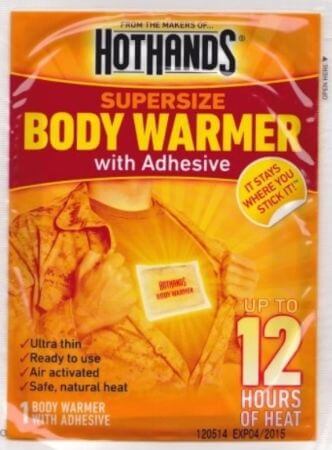Here I’m going to be sharing with you my 10 favorite uses for chemical hand warmers.
The way these things work is you take them out of the packet and the chemicals inside them react with the oxygen in the air and that causes an exothermic reaction creating heat.
Depending on which ones you buy, this heat lasts for varying amounts of times.
My particular favorite brand of these are called HotHands hand warmers. They last for about 10 hours. They don’t quite last that long, certainly not at the full heat output, but they are very good. If you start them off late at night, they’re certainly adequate to get you through a full night until the next morning.
I’m going to share with you a couple of very obvious uses for these and then I’m going to show you a few that aren’t quite so obvious.
Use one for hand warmers is the most obvious one. They’re called hand warmers and you can use them to keep your hands warm. 🙂
I do that in a couple of different ways. Sometimes I put them down inside my gloves, sometimes I put them in my pockets and just walk with my hands in my pockets.
But either way, for keeping your hands warm on a cold day, they’re great.
Use two for hand warmers is another fairly obvious one. Really you can use them for keeping your feet warm. You can actually buy versions of these that are shaped to fit inside the toe of a shoe and they’re pretty good as well.
They’re not the most comfortable things to have underneath your toes as you’re walking along, but if you can get them to sit on top of your toes, then they’re absolutely fantastic. I wouldn’t recommend putting them inside your sock because there have been reports of people getting chemical burns from them. I read a report of someone having used a hand warmer to keep their feet warm and they did get quite itchy, irritable chemical burns from the reaction going on inside the hand warmers. So just be aware of that and keep them outside your socks.
The next use I’ve got for hand warmers is directly related to the one I just said, keeping your feet warm, but this is keeping your feet warm at night.
When you get down inside your sleeping bag, quite often your feet can be pressed against the bottom of your sleeping bag, which compresses all of the insulation in your sleeping bag and that can reduce its effectiveness, which can lead to you getting cold toes.
What I like to do on a cold night is I wear two pairs of socks and I put one of these hand warmers in between the pairs of socks to keep my feet warm all night and that works an absolute treat.
The fourth use for hand warmers is also a sleep related one and that is that you can put three or four of them in your sleeping bag to pre-heat it, get a bit of warmth through the insulation, which can encourage the insulation to loft a little more efficiently and leave all that nice warmth inside for when you get in a bit later on.
After that you can put a couple of them in your socks or transfer them to the outside of your sleeping bag, even under your sleep pad. So, that’s number four, preheating your sleeping bag.
Number five is one that’s not immediately obvious to everyone, but if you’re out in minus temperatures and you have limited amounts of space in your tent, meaning you can’t keep your water inside the tent with you, you can use hand warmers to stop your water freezing overnight.
You just put one of them down wherever you’re keeping your water, pop your water over the top of it and it’ll just put enough warmth through the liquid to stop it freezing. So number five, stopping your drinking water from freezing.
Number six is a good one. You can actually use it to improve the efficiency of your gas canisters.
If you use a stove that uses a gas canister, generally it has a little hollow in the bottom of it, a dome shape in the bottom of the can. If you pop one of your hand warmers underneath that, it’ll just stop the gas from getting really cold. It’ll stop that gas from getting really cold, which can decrease the pressure inside the can and cause you to have some problems with getting a real good warm burn on your stove.
So pop a hand warmer underneath your gas canister. It’ll warm the gas slightly and that will allow your stove to burn more efficiently.
Number seven is keeping your electronics warm. Did you know that rechargeable batteries really hate getting cold?
In fact if you keep them at a low temperature, down in single figures, for a long period of time, they’ll actually discharge and when you come to put them in your camera or your drone or whatever it is that you’re keeping the spare batteries for, you’re going to get a nasty surprise. Because there’s not going to be much power left in them.
So pop a hand warmer in a bag, put all your batteries in there, and it’ll keep them nice and warm and make sure they retain as much of their charge as possible.
Use number eight for hand warmers is to use them to dry out wet socks and boots overnight.
With socks what I’d recommend is to pop a hand warmer inside each one and hang them if you can. With boots, keep the boots somewhere where there’s a little bit of airflow, but not too much and pop a hand warmer inside the toe box of each one.
I wouldn’t recommend that as your regular method of drying out boots because manufacturers tend to recommend that they dry in ambient temperatures. But if you are at the end of a long day of hiking, you’ve got to put your boots on the next morning, it’s a good way of getting some of the moisture out of them by the next morning.
Number nine is a great one for anyone that uses a digital camera, in particular one with an interchangeable lens. We’ve all been there. You take a photo, you framed it up nicely, you think that’s great, you look at it on the screen and oh my god, there’s a great big foggy patch, either right in the middle or up in one corner.
That’s because you’ve possibly had the camera out and the lens out in the cold air for too long and condensation has formed on the lens.
You can buy USB powered electronic lens warmers, which go around the outside of a camera lens, but they’re quite expensive.
What I do is I get a piece of tubular bandage or an old sock that I’ve cut the bottom off to make a tube. I put that tubular bandage or less elastic part of the sock over my lens and I pop a hand warmer inside that, on the underside of the lens.
What that does is it just increases the air temperature inside the lens and inside the camera to stop any condensation forming on the outer surfaces of your lens and camera.
It doesn’t cause so much heat that it distorts the lens inside, but it does work absolutely brilliantly for stopping fogging up of camera lenses.
Number 10 of my favorite uses for chemical hand warmers is one that really made me go “what, really?”
I was reading an article and someone mentioned that after dropping their phone in a puddle, they took it home and put it in a plastic bag with some rice and a used hand warmer.
It seems that used hand warmers are absolutely brilliant at absorbing moisture. They’re a little bit like silica pouches that you get in new electrical equipment.
So you get yourself a used hand warmer and you pop it into anything that you want to keep dry or in with something you’ve dropped in a puddle and you’re trying to dry it out, or anything along those lines, a used hand warmer will absorb all of the moisture in the air and will help you to get that dried out.
I think is absolutely brilliant idea!
I would definitely recommend giving it a go. A used hand warmer to help you dry out any waterlogged electronics.
That’s my 10 uses for chemical hand warmers.

For over 12 years, I have been testing and reviewing heating technologies that overcome cold weather conditions. In recent years, I have specialized in the heated apparel. I’ve made it my mission to educate people about heated clothing.


